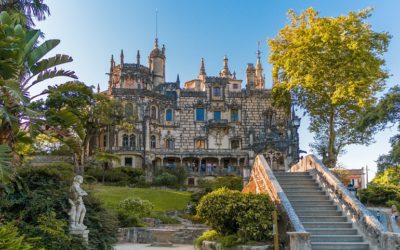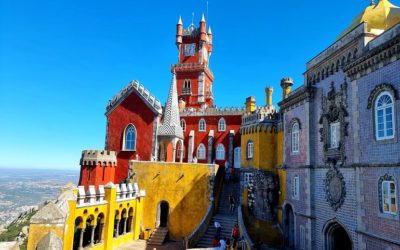Portugal Travel Tips
The Best Guide to Exploring PortugalThis article may contain affiliate links and at no additional cost to you, we earn a commission if you make a purchase. Also, as an Amazon Associate, we earn from qualifying purchases. For full information, please see our disclaimer.
PORTUGAL QUICK INFORMATION
Are you ready for a new adventure in the Mediterranean? Stop wondering where to travel next because I will show you an amazing country in the west of Europe – Portugal. It is home to picturesque beaches, stunning coastlines, green lush valleys and mountains, delicious food, and a strong cultural heritage. Portugal is a real gem and a place that offers something for everyone.
LISBON – THE CAPITAL OF PORTUGAL
Let’s start this Portugal travel guide with one wonderful city and one of the leading economic centers on the continent – Lisbon (Lisboa). It is the capital of Portugal, located in the western Iberian Peninsula on the Atlantic Ocean and the River Tagus, home to about 2.9 million people. The capital of Portugal is one of the two Portuguese cities, together with Porto, recognized as a global city. In addition, Lisbon is one of the oldest cities in the world. Here you will also find two sites listed by UNESCO as a World Heritage Site: Belem Tower and Jeronimos Monastery (below.) I will tell you more about them in the post about our day trip to Belem.
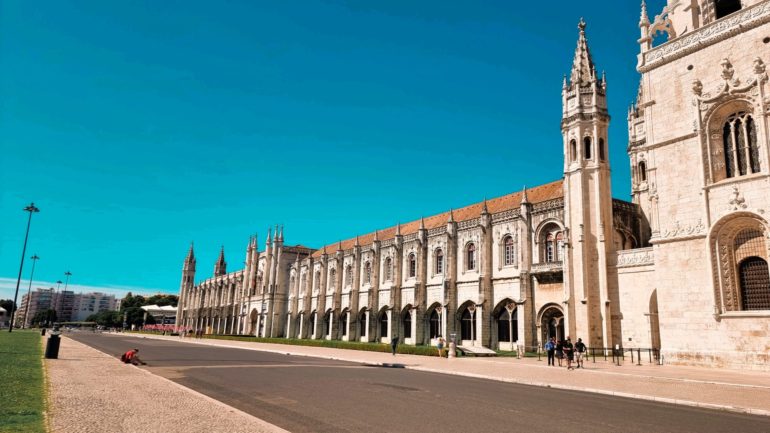
LANGUAGE
Portuguese is a Romance language, the official language of Portugal, Angola, Mozambique, Guinea-Bissau, Cape Verde, Sao Tome and Principe, and Brazil. But it is also a co-official language in East Timor, Equatorial Guinea, and Macau. By native speakers, it is the sixth-most spoken language in the world and the second in Latin America. So if you speak Portuguese, it will be easy to visit all these countries. In Portugal, English is also widely spoken – we didn’t have any issues communicating with locals.
RELIGION
The main religion in Portugal is Christianity, with 81% of the population Catholic. The country is one of the most religious countries in Europe.
CURRENCY
Euro is the currency in Portugal. Banks are open until early afternoons from Monday to Friday (08:30 to 15:00 or 16:00) and until midday on Saturdays. You can use your international bank cards here – Visa, American Express, Diner’s Club, Mastercard. Usually, you can easily find an ATM, but be careful and look for an ATM of a Portuguese bank (you will be less charged than by Euronet).
ELECTRICITY SOCKET
The electricity is 230V AC, and the power outlets are usually from type F. You can use your electric stuff in Portugal if the standard voltage in your country is 220 – 240V (the UK, Europe, Australia, most of Asia, and Africa). But if it is in the range of 100 – 127V (the US, Canada, and most South American countries), you need a power plug adapter/voltage converter.
PORTUGAL VISA
If you are from a country member of the Schengen Area, you can freely travel within the whole Schengen Zone, and you don’t have to apply or obtain a Schengen visa. However, other nationalities will need to apply for a Schengen visa to travel to the country. For more information, you can check the site of the Ministry of Foreign Affairs. For Coronavirus updates and requirements, the news on Re-open EU or the airport websites can come in handy.
HISTORY OF PORTUGAL
If you are interested in history, so Portugal is your country! It is one of the oldest countries in Europe.
Over the years, Portugal has experienced ups and downs. At the end of the 9th century, King Alfonso III of Asturias established a county based in Portus Cale. The Kingdom of Asturias was later divided, and northern Portugal became part of the Kingdom of Leon. But during that time, Portugal grew stronger and gained independence during the weak Leonese reigns.
Later at the end of the 11th century, the Burgundian knight Henry became the count of Portugal and defended Portugal’s independence by merging the County of Portugal and the County of Coimbra. The son of Henry, Afonso Henriques, announced himself king of Portugal in 1139 with Guimaraes as capital, changed to Lisbon in 1255.
Do you remember the lessons about maritime exploration and colonization, Bartolomeu Dias, Vasco da Gama? Here Portugal played a significant role. In the Middle Ages (15th – 16th centuries), Portugal was a world power during Europe’s “Age of Discovery.” It built up an empire with possessions in South America, Africa, Asia, and Oceania but slowly lost much of its wealth and status because of the Dutch, English, and French.

Later, Portugal was weakened by the earthquake in 1755 in the capital, occupation during the Napoleonic Wars, and the loss of its largest colony Brazil in 1822. In 1926 a military coup installed a dictatorship until 1974. After that time, the new government began democratic reforms and granted independence to Portugal’s African colonies in 1975. Portugal is a founding member of NATO and entered the European Union in 1986.
SAFETY
Add this safe country to your travel bucket list! Portugal is the fourth safest country in the world for 2021 (behind Iceland, New Zealand, and Denmark).
Yes, there are some scams, but Portugal is a safe place to go. However, you should be careful with your personal belongings as a tourist, especially in hotspots and crowded places like Lisbon or Porto. So, you could avoid pick-pocketing, which is actually rare in Portugal. Be cautious in the nightlife areas (Algarve, for ex.), too, so you can prevent violence and stay safe. You will also notice some guys in the evening/night in places like Lisbon, Porto, Algarve who whisper “hashish, marijuana” as you walk past.
But don’t let these small things stop you from exploring Portugal. It is generally easy to travel through the country by train or bus, but if you can – rent a car. We think it’s definitely the best way to go and see the remotest parts of the country. Just be careful. And of course, don’t travel without insurance.
PORTUGAL TRIP PLANNING
WEATHER
Let’s continue this Portugal travel guide with the “weather forecast.” While you can visit Portugal all year round, avoiding the winter season might be wise, especially from November to March, when rainfall can occur. The Atlantic Ocean influences the climate of Portugal. It is cool and rainy in the north, but it becomes warmer and sunnier if you go south. For instance, south in the region of Algarve, the climate is dry with sunny days.
The best time to go to Portugal is Spring (May – June) or Autumn (September – October) if you want to explore the country. If you decide to spend your summer holiday here, avoid the high season in July and August. It is scorching and full of tourists (unless this is what you are searching for 🙂 ). But on the coasts, the heat is less common and intense, and you can find some cooling there. (Especially in the ocean – the water was a little bit cold for me – around 19°C (66°F) in October, but it was already out of the summer season).
In a nutshell, the weather in Portugal is warm. I visited Portugal in October, and the weather was great for all-day walks outside – sunny and warm. You can wear a T-shirt or light jacket and shorts during the daytime, and in the evening, it gets not so cold (for me, a light jacket was absolutely fine). The maximum temperatures during the summer (when influenced by heatwaves from Africa) can exceed 36°C (97°F) on the coasts, and 40 °C (104°F) in inland areas. On the other hand, the winter is short, with an average temperature in January around 10°C (49 °F). In other words, Portugal is a perfect place to spend the winter months (especially if you live in a cold northern country).
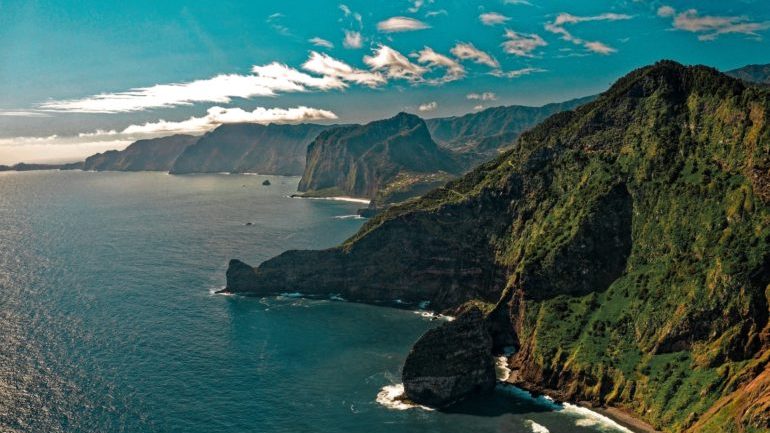
TRANSPORT
There are plenty of options with direct flights to Portugal, especially from airports within or close to Europe – WizzAir, TAP Portugal, Ryanair, EasyJet, and many more. There are currently 3 main international airports on the continent located in Lisbon, Porto, and Faro. Portugal, Madeira, and the Azores also offer many yacht harbors ready to welcome the tourists arriving by sea.
When you are in Portugal, traveling from one place to the next is relatively easy. You can use the well-organized public transport if you want to travel cheaper. Portugal has a good railway system covering the whole country. The Portuguese railway company CP (Comboios de Portugal) operates on the mainland at reasonable prices. We used them several times and were satisfied (even when one of our trips (to Sintra) was during a strike.) Both Lisbon and Porto also have a metro system.
You can use transport companies as FreeNow, Bolt, Uber, and travel relatively cheaply. You only need to download their apps. Tuk Tuk is also a popular attraction for tourists to get around the cities in Portugal. However, if you prefer your own kind of transportation, renting a car can help you discover every part of this beautiful country.
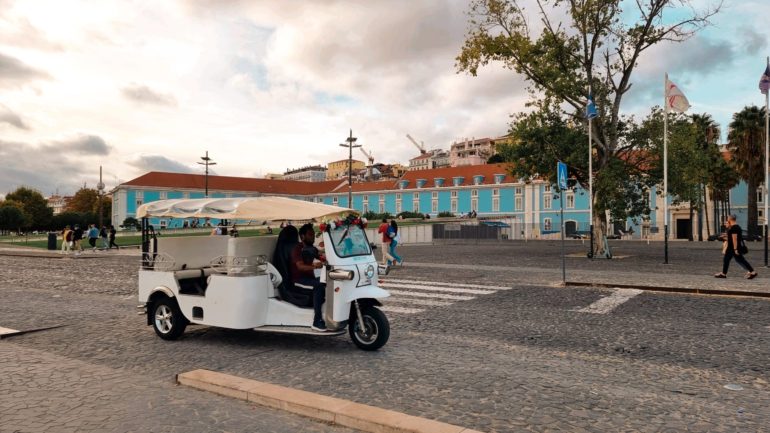
BUDGET
It depends on you and your wishes. You can spend your holiday around for as cheap or as expensive as you want. My experience shows that a trip to Portugal can cost about 60-80 EUR a day. These costs include accommodation, food, transportation, and activities being the most considerable expense. But you can do this much cheaper if you are on a budget. Or if you prefer staying in hotels and eating out in restaurants, you can expect this to be higher. For example, if you eat local street food, you can get a pasteis de Nata (read more about the local food in Portugal below) for about 1.15 EUR. You can choose the famous Francesinha sandwich for lunch for about 7 EUR (the portion is really big). But eating in restaurants will be more expensive – 10 – 15 EUR for a single dish.
WHAT TO PACK FOR TRAVELING TO PORTUGAL
Traveling around Portugal is generally easy, except for a few colder months (November – February).
For Lisbon and the south coast in winter, take closed shoes, a light jacket, a sweater, and a rain jacket and umbrella. For the northern parts (Porto) – a bit heavier jacket will be fine. If you want to go to the countryside and mountain areas, you will need warm clothes and a raincoat. In summer don’t forget to bring light clothes, a sun hat and sunglasses, a light scarf for the sea breeze, and a sweatshirt for the evening.
As a quick overview, here are some of my must-bring items while traveling:
– a portable water filter bottle, so I always have something to drink on hot days;
– a sand-free beach blanket, because in Portugal there are lovely beaches you would like to visit (I will show you some of them);
– a good pair of travel shoes for the journey. They are very important! Remember it! (I will show you the steep streets in Lisbon and Porto, where comfort shoes are essential for long walks).
– having a light power bank with you might be a good idea, especially if you take hundreds of photos and reels for your Instagram.
– be sure to pack some food and water if you go out of the cities, too. They were so important during our trip to Sintra when we wanted to see as much as possible and didn’t want to spend much time eating in a restaurant.
PORTUGAL TRAVEL TIPS: THE BEST THINGS TO DO
WHAT IS PORTUGAL FAMOUS FOR?
As mentioned, Portugal has a little bit of everything for everyone. Touring the towns on foot will provide you with some stunning views, but it could be a little bit challenging and tiring. So, combine it with public transport, and you will easily explore them, feeling the local atmosphere. And don’t forget to take lots of photos – to show them to your friends who can’t travel to Portugal or just to make them jealous (Oh, I won’t tell you how many photos we took…)
Below you can find my recommendations on the best things to do in Portugal.
EXPERIENCE LISBON
We started our trip from Lisbon – this sunny hot city where the sun shines almost the whole year and the temperature rarely drops below 15°C. It is a fantastic historical city full of stories, activities, and fascinating attractions, waiting for its tourists all year round – a bustling and exciting place. There are temples, ancient buildings, museums, restaurants, shopping areas, and attractions that bring different cultures together (Castelo de Sao Jorge, Museu Nacional do Azulejo, Elevador de Santa Justa, Se cathedral.) With so many various activities, it is a popular weekend city break destination.
Note: But remember and be prepared – Lisbon extends over seven steep hills, and you should expect a lot of uphill walking!
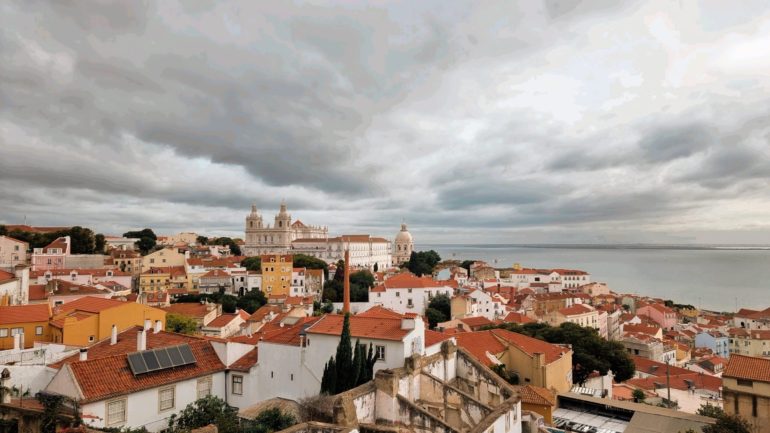
EXPLORE THE REST OF PORTUGAL
In this travel guide to Portugal, I am trying to show you the country’s main spots. Be sure I will share more information about them and other hidden gems in my detailed posts. I hope it will help you choose the most attractive places for you.
After you’re done exploring Lisbon, continue your trip towards the cities in the rest of Portugal. Get the most out of the beaches on the Atlantic Ocean and indulge in a few days relaxing and swimming in the crystal water. If you prefer historical places, don’t miss some of the finest examples of ancient cities – Sintra, Coimbra, Guimaraes, and Braga. Fancy seafood? Try the most delicious Portuguese dishes in the fishing villages as Nazare, Baleal, Aveiro while enjoying the beautiful sea view. What about a drink and a party at night? If yes, so visit Lagos, Albufeira and Praia da Rocha – the top resorts for nightlife. Wanna stay in luxury hotels? So resorts as Quinta do Lagos, Vale do Lobo, and Almancil are your places.
THE BEST THINGS TO SEE IN PORTO – OLD AND NEW COME TOGETHER
The second-largest city in Portugal is rich in history with centuries-old buildings, sights, and places to take you back in time. The old town of Porto, centered at Ribeira, built on hills overlooking the Douro River, is a UNESCO World Heritage Site – something to behold and experience. Also, a point of interest is the 14th-century Sao Francisco church, an architectural gem of this elegant city. In addition, visit the local port wine cellars, mainly located across the river at Vila Nova de Gaia, where the nightlife is waiting for you. And of course, don’t miss the fantastic sunset from the Dom Luis I Bridge – one of the most beautiful places in Porto and one of my favorite sunset spots. Such incredible colors of the sky!
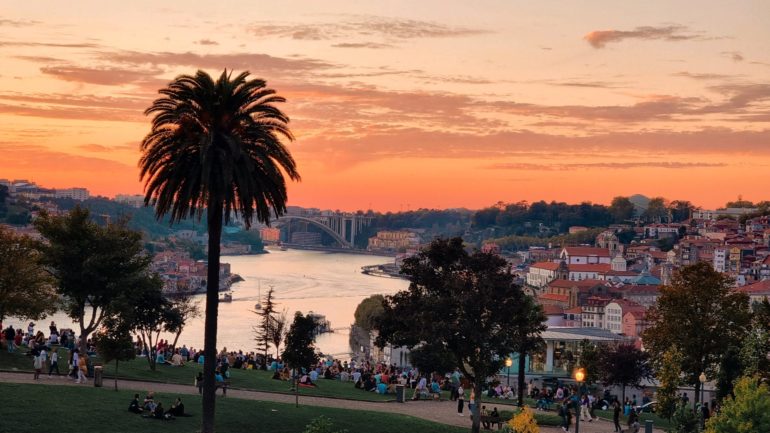
SINTRA – THE PERFECT DAY TRIP FROM LISBON
Sintra is not so far from Lisbon, so it is the perfect day trip in the region.
Note: If you have a chance, do it as a two-day trip. You won’t be in a hurry and will have the opportunity to explore all the exciting spots around. Believe me – they are a lot!
It’s a UNESCO World Heritage site, situated within the hills of the Serra de Sintra, filled with castles, palaces, and beautiful natural scenery. It is an outstanding tourist destination that you should explore. Palacio da Pena, Quinta da Regaleira, Palacio de Monseratte are only a few of the sights here that are worth visiting. So, if you have the chance to travel to Sintra, don’t miss it! It is one of my favorite towns in Portugal, where I definitely would like to go again.
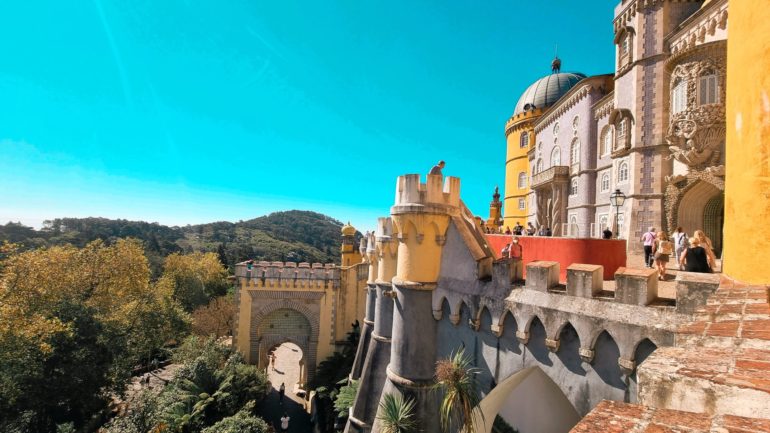
THE PARTY CENTERS OF PORTUGAL – ALGARVE AND LAGOS
Let’s now check some party centers in Portugal where you can spend your next summer holiday. If you are looking for a modern atmosphere, luxury hotels, and entertainment venues, you can find your area below.
Have you heard about Algarve until now? Probably Yes, as this is one of Europe’s most popular holiday and nightlife destinations. It’s also one of the top clubbing destinations of Europe (of course, during the pandemic, there are some changes like everywhere, but it is still a lively spot). You can choose between the top resorts for partying Lagos, Albufeira, and Praia da Rocha, and the resorts of Quinta do Lagos, Vale do Lobo, and Almancil, known for their luxury nightlife and hotels. These are popular among couples and groups of travelers looking for entertainment, good food, and nightlife as a vital part of their holiday.
EXPLORE THE OFF-THE-BEATEN-PATH PLACES IN PORTUGAL
Being a diverse country, people come to Portugal for a variety of reasons. So, apart from visiting the usual places like Lisbon, Porto, and Algarve, check out such unusual and not-so-bustling places in Portugal as Nazare, Geres National Park, Praia da Adraga, Braga. So, you can have a chance to see some breathtaking views and impressive natural attractions. Another option for the more adventurous of you can be the Camino Portugues part of Camino de Santiago. Pass stunning coastlines, beautiful sandy beaches, fantastic cities like Lisbon, Fatima, Porto, Tui, Santiago, and get to know people from the whole world.
GO HIKING AND CAMPING IN PORTUGAL
Are you an adventurous person? If yes, so plan to visit Portugal for your next hike. When? The best time for hiking is during the shoulder seasons of spring and fall when you can see Portugal’s green fields. You can do excellent hikes in the northwestern corner of Parque Nacional da Peneda-Geres, where you will find the picturesque Castro Laboreiro Loop. The fascinating Covao dos Conchos in Portugal’s rugged Serra da Estrela natural park is an incredible spot worth the hike if you’re road tripping Portugal. Located in the Serra de Sintra coastal mountain range, Sintra is also home to many lovely hiking trails. One of Sintra’s best hikes is the Santuario da Peninha Trail, which sits on a rocky outcrop overlooking the Atlantic Ocean. Just be well prepared for your hike and have warm clothes (it gets cold at night).
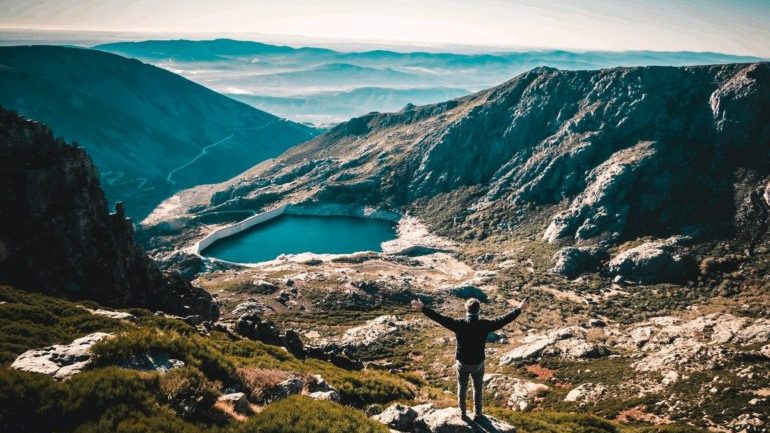
FIND THE BEST BEACHES IN PORTUGAL
Portugal offers around 940 km coastline (with the archipelagos and Madeira) with many beaches with crystal waters worth visiting. You will find sandy beaches, cliff coastlines, surf sides, offering plenty of activities that could diversify your vacation.
Most sun-seekers go directly to the top resort beaches of the Algarve. Others interested in windsurfing and kitesurfing find here one of Europe’s top destinations – Guincho Beach, in a spectacular location on the Lisbon coast in Cascais. Don’t miss also beaches like Praia Baleal, Praia do Cabedelo, Praia da Figueira, Camilo Beach. You will admire some fantastic views.
Have you been to Portugal on vacation? What is your favorite beach there?
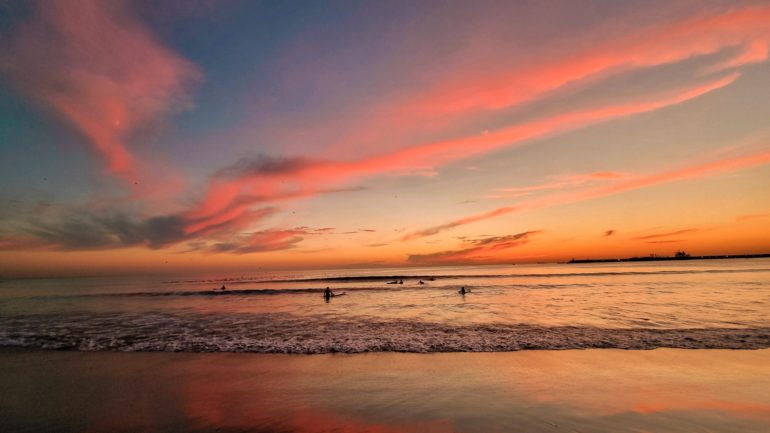
EXPLORE THE ISLANDS – THE AZORES AND MADEIRA
OK, OK, in this Portugal travel guide I can’t miss also the incredible islands of Portugal, where you will find natural beauty in the blue waters of the Atlantic Ocean: The Azores. The Azores, along with Madeira, is one of the two autonomous regions of Portugal that you should visit. It is an archipelago in the Macaronesia region of the North Atlantic Ocean. These nine islands are Flores and Corvo (west); Graciosa, Terceira, Sao Jorge, Pico, and Faial (center); and Sao Miguel, Santa Maria, and the Formigas Reef (east). You will find beaches of warm white sand, natural waterfalls, lakes, and vineyards. A trip to the islands is a must.
Madeira provides stunning landscapes and is one of Europe’s most beautiful travel locations visited by thousands of tourists every year. You can expect spectacular views, Funchal’s famous cuisine, relaxing promenades, and other endless opportunities for more adventurous of you. Choose from Levada walking, hiking, mountain walks, sailing, dolphin watching, scuba diving, big game fishing, surfing, canyoning, paragliding…
TOURS AROUND PORTUGAL
If traveling by yourself isn’t your thing, check out the variety of tours offered across Portugal.
If you are in Lisbon, you can choose one of the following tours around:
-A day trip from Lisbon to Sintra and Cascais – I think that Sintra is worth a visit and if you are interested in history and royal life, you should include such a day trip in your plan
-A day trip from Lisbon to Fatima, Nazare, and Obidos – Experience the rich heritage and stunning countryside of Portugal
-In Lisbon – a Portuguese food and wine tour – If you are a food and wine lover, going on this tour could be an exciting experience to learn more about Portuguese cuisine
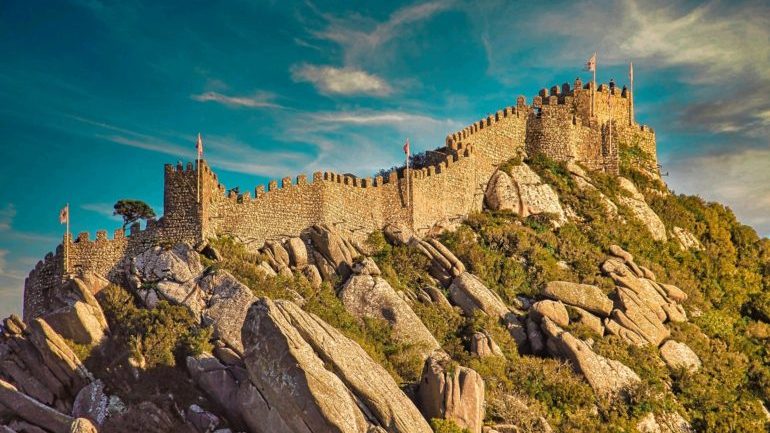
WHAT TO EAT IN PORTUGAL – TRADITIONAL FOOD YOU SHOULD TRY
This Portugal travel guide won’t be full without one of the most important parts of every trip – the traditional food. Eating in Portugal is a rich experience inspired by local produce and has similarities in flavor to neighboring countries. With traditional recipes passed on through the generations, the local Portuguese food is something you need to try. As a country surrounded by the ocean, fish is traditionally highly used. If you like Mediterranean cuisine, here you will find some similarities. Sea and meat lovers will like the traditional Portuguese food – shellfish, cod, octopus, beef, pork – you’ll be spoiled for choice. Of course, vegans and Vegetarians won’t stay hungry, too. And not to forget – the Portuguese know how to prepare tasty pastries and sweets… OMG, I ate so many of them! But you know – “Vacation calories don’t count!” Yummy!
So, here are the most famous Portuguese dishes that you should try:
Pasteis de Nata: Yes, this is the most well-known Portuguese sweet delicacy that you can find everywhere. The pasteis (or pastel) are made with puff pastry shells stuffed with yellow egg yolk custard. The custard is flavored with lemon and sugar and usually topped off with powdered sugar and/or cinnamon (for me both). If you are in Lisbon, you will definitely visit Belem – don’t miss the original Pasteis de Belem produced since 1837 in the same name bakery (a pack of 6 pasteis is a good start of the Belem tour.)

Traditional Bacalhau: The Portuguese love cod, and they are the biggest consumers in the world. They eat cod in every possible way – salted and dried cod is one of the foods you’re bound to come across. Bolinhos de bacalhau, bacalhau a lagareiro, bacalhau a bras are only few of the dishes you will find in almost every restaurant here.
Francesinha: Two thick slices of bread with different varieties of meat, usually some ham, sausages, and steak. It’s covered with melted cheese and delicious spicy tomato sauce. Most often topped off with a fried egg and served with french fries.
Port Wine: Port wine is sweeter, richer, and has a higher alcohol content than other wine varieties. Maybe you are not a wine lover, but don’t miss the chance to try the original worldwide famous Port wine.
Oh, I admit, we didn’t have the chance to try all the traditional Portuguese dishes we wanted… but we will continue next time.
Recommended food tours
If you’re a big foodie like me, I recommend going on a food or wine tour during your trip. The local insight of the guides is fantastic, giving you a better understanding of Portuguese cuisine. Maybe you will like some of the food tours in Lisbon, Porto, or visit the Douro Valley tour if you have enough time.
PLACES TO STAY IN PORTUGAL
The accommodation options in Portugal are numerous and varied – hotels, hostels, villas, self-catering apartments, guesthouses, campings, Airbnbs.
Note: Something interesting – the Portugal historic hotels “pousadas.” They are in some of the most iconic and beautiful palaces, monasteries, and castles, now repurposed into luxurious tourist lodgings.
During the high season in Portugal, from June to September, accommodation prices can be significantly higher. Book in advance because the tourists quickly snap up the better accommodation options, and prices increase as a result. Prices vary depending on the time of booking and location. (In October, we stayed in a guest house in Lisbon and an apartment in Porto with a reasonable price – 45 EUR/night.) So, find out what suits you best.
MOVIES TO WATCH (FILMED IN PORTUGAL)
As well as being famous for its beaches and architectural sites, Portugal is also a popular filming location. It is a perfect backdrop for many films with spectacular beaches, dramatic cliffs, stunning landscapes, and ancient buildings.
You should have probably watched the movies about Agent 007. But have you noticed that a long time ago the movie “007 – On Her Majesty’s Secret Service” (1969) was filmed in Portugal? There are scenes in Praia do Guincho, Setubal, Zambujal, Lisbon and Cascais.
Another interesting one if you plan a trip to Lisbon is the movie “Night Train to Lisbon” (2013). It presents Portugal’s capital and is like a free guided walking tour through Lisbon itself.
At the same time, “That Good Night” (2017) presents the suburban side of Algarve and the village lifestyle of the locals.
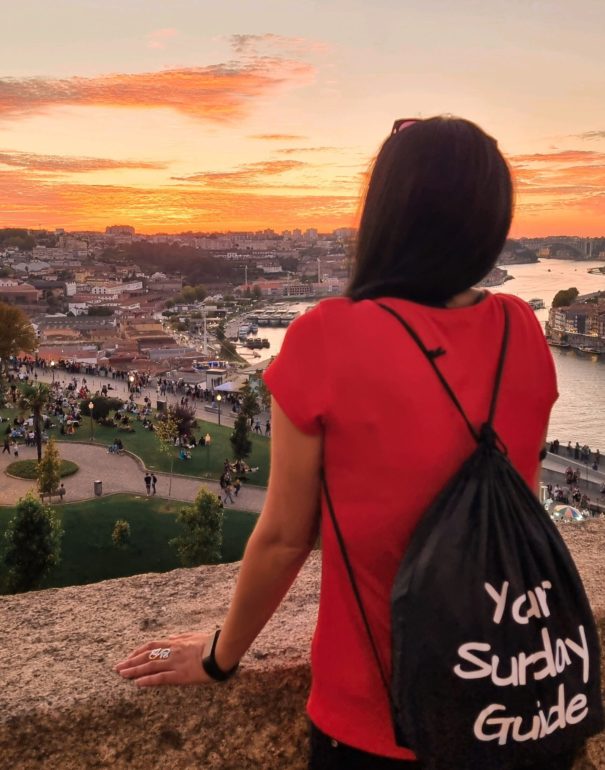
I hope this Portugal travel guide will come in handy and you will enjoy your trip! Visit Portugal!
Thank you for being here!
Your Sunday Guide,
Lucy
** Travel buddy for the trip to Portugal – Vlad. Thank you! 🙂
Latest From Portugal
Best Things to Do in Sintra: The Mysterious Quinta da Regaleira
Sintra – one of the best day trips from Lisbon, offers so many amazing things to visit. The mysterious Quinta da Regaleira is an exciting stop on any Sintra day trip and is easily one of the best places to visit in Sintra. Located not far from the old town center of...
Best Things to Do in Sintra: The Fairy-tale Pena Palace
Have you ever been to Sintra? No?! So, it is time to add Sintra to your list when planning a trip to Portugal. It is such a fantastic place where you can create unforgettable memories of your Portugal holiday, and you won't regret spending a day or two here. This town...

